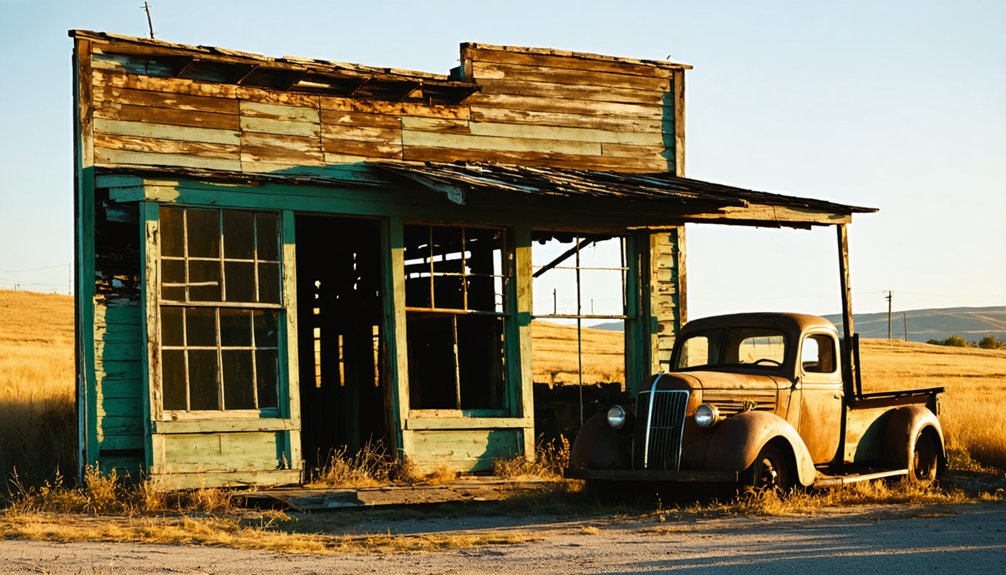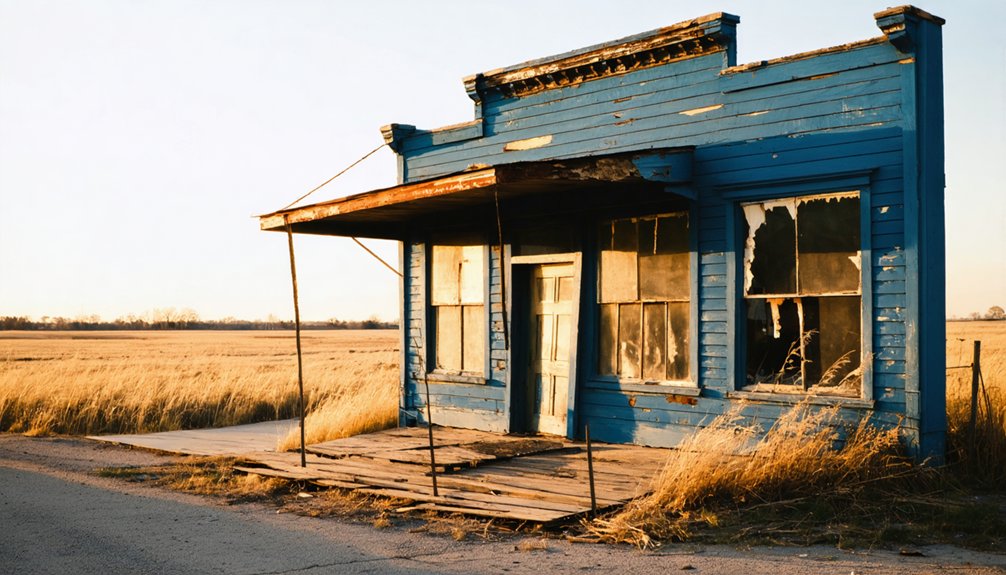You’ll find Old Ashton’s haunting ruins scattered along a forgotten South Dakota rail line, where a bustling prairie boomtown once housed 430 residents in 1910. The town’s T-shaped layout, anchored by grain elevators and general stores, flourished briefly until harsh winters and economic decline took their toll. Today, weathered wooden structures and crumbling railroad buildings stand as silent witnesses to frontier life, holding countless stories of pioneer determination and prairie prosperity.
Key Takeaways
- Old Ashton was established in 1881 as a railroad boomtown in South Dakota, reaching its peak population of 430 residents by 1910.
- The town’s decline began after losing the county seat to Redfield in 1886 and accelerated during the Great Depression.
- Remnants include crumbling railroad buildings, abandoned grain elevators, and weathered wooden structures that showcase early frontier construction methods.
- The Westlakes attempted to revive Old Ashton as a tourist attraction in the 1980s, featuring a rock shop and guided tours.
- The ghost town lacks modern tourist infrastructure but preserves authentic ruins of a once-thriving railroad community.
The Rise of a Railroad Boomtown
While many frontier towns sprang up organically across South Dakota’s landscape, Ashton’s story began with a calculated move in 1881, when the entire settlement relocated to align with a newly surveyed railroad line.
You’ll find that railroad significance shaped every aspect of Ashton’s transformation. As tracks were laid, the town’s population surged, reaching 430 residents by 1910.
The railroad’s arrival triggered an explosion of commerce – grain elevators rose along the sidings, general stores opened their doors, and a bustling depot became the heart of community life. The town followed a typical T-shape layout with its commercial avenue running perpendicular to the tracks. The town’s prominence was short-lived when Redfield became county seat in 1886.
This economic transformation wasn’t unique to Ashton. Across South Dakota, towns like Parkston raced to position themselves near rail routes, knowing their survival depended on it.
The railway brought essential connections – mail service, telegrams, and access to distant markets that turned these frontier outposts into thriving commercial hubs.
From Prairie Settlement to Ghost Town
As harsh prairie winters swept across South Dakota’s landscape, Ashton’s once-thriving community began a gradual descent into abandonment.
Like many prairie settlements, the town faced brutal settlement challenges that tested the limits of its pioneers. You’ll find echoes of community resilience in stories of homesteaders who persisted through severe weather and agricultural hardships, raising cattle and cultivating grains against seemingly impossible odds. Railroad workers departed shortly after the town’s establishment, marking the first wave of population loss.
Prairie pioneers faced relentless hardships, yet their unwavering spirit endured through brutal winters and unforgiving soil to build lasting communities.
When the Great Depression hit, many residents left for urban opportunities, accelerating the town’s decline.
The later loss of rail service and being bypassed by major highways sealed Ashton’s fate. While some families attempted to reinvent the settlement through tourism ventures, these efforts couldn’t sustain the community. Just as in nearby Rockerville, declining tourist traffic eventually led to complete abandonment.
Today, you’ll discover only scattered ruins and abandoned structures, silent testimonies to the dreams of prairie settlers.
Life During the Golden Years
The bustling years of Old Ashton’s prosperity paint a vibrant picture of prairie life at its peak. You’d find railroad workers mingling with merchants at the general store, while farmers hauled their grain to the elevator.
Family dynamics centered around one-room schoolhouses and church gatherings, where European immigrants shared their cultural traditions through stories and song.
Life ebbed and flowed with the seasons. You’d see the town swell with seasonal labor during harvest time and railroad construction, then quiet down during harsh winter months. Just like many Black Hills settlements, the community depended heavily on mining and transportation for its economic survival. Much like the town of Okaton, the community thrived until railroad operations ceased, leading to its gradual decline.
Residents pulled together, helping neighbors through blizzards and drought. While railroad managers lived in sturdy homes, laborers made do with simple dwellings.
Despite the challenges of isolation and weather, the community’s spirit remained strong through mutual aid and shared celebrations.
Westlake’s Tourist Venture
You’ll find Westlake’s ambitious 1980s roadside tourist venture operating out of an old rock shop along the main highway through Old Ashton.
Much like Chez Ashton restaurants in Quebec, the venture attempted to capitalize on regional tourism by selling local minerals and offering guided tours of the ghost town’s remaining structures.
Despite initial promise and earnest efforts to create a sustainable attraction, Westlake’s tourism business ultimately couldn’t maintain enough visitor interest to survive long-term. Today, visitors pay seven-fifty admission fee to explore the historical buildings and artifacts at their own pace.
1980s Roadside Attraction
During the 1980s, Robert and Evelyn Westlake transformed sleepy Okaton, South Dakota into a unique roadside attraction after relocating from Illinois.
You’d find their venture, branded as “Westlake’s Ghost Town,” beckoning you from Interstate 90 with eye-catching signage promising roadside nostalgia and vintage appeal.
If you’d pulled off the highway, you’d discover their carefully crafted tourist trap featuring a western-style ghost town façade attached to the general store.
The site offered a delightful mix of attractions: a well-stocked rock shop, functioning gas pumps, and a charming petting zoo. You could grab refreshments, including drinks and sandwiches, while exploring the grounds.
While the Westlakes’ dream eventually faded when they sold their interest, their venture briefly breathed new life into this bypassed railroad town.
The town’s decline accelerated after the railroad tracks became disused in 1980, making the Westlakes’ tourist attraction even more significant to the local economy.
Much like the buried treasure at Long Lake that drew curious visitors, the Westlakes’ ghost town attracted travelers hoping to discover something unique in South Dakota.
Rock Shop Operations
At the heart of Westlake’s Ghost Town attraction stood their vibrant rock shop, a tribute to South Dakota’s rich geological heritage.
You’d find yourself drawn into a world where rock specimen sales met geological education, offering a hands-on experience with the Black Hills’ ancient treasures.
The shop’s success centered on three key features:
- Direct partnerships with local museums, enhancing the educational value of each displayed fossil and mineral
- Seasonal guided tours that let you discover the region’s geological wonders firsthand
- Interactive workshops where you’d learn about fossil identification and mineral classification
During peak tourist seasons, you’d join fellow geology enthusiasts examining rare specimens while learning about conservation efforts that protected these irreplaceable resources for future generations to discover and enjoy.
Failed Tourism Legacy
The stark reality of Old Ashton’s failed tourism ventures stands in sharp contrast to the initial optimism that surrounded the site.
You’ll find no interpretive signs, restored buildings, or visitor amenities that might’ve transformed this ghost town into a vibrant heritage destination. Unlike successful regional attractions such as Four Mile Old West Town, Old Ashton never developed the infrastructure needed to draw tourists.
The town’s tourism challenges mirror its broader economic decline.
You won’t discover any trace of organized tours, visitor centers, or promotional materials that could have helped preserve its rich history, including the notable Hamley brothers’ saddlery from 1884.
The absence of investment, both public and private, has left Old Ashton largely forgotten, with no digital presence or dedicated preservation efforts to share its story with modern visitors.
Remnants of a Forgotten Era
As you explore Old Ashton’s weathered landscape, you’ll find the skeletal remains of railroad buildings that once bustled with activity.
The abandoned wooden structures, now warped by decades of prairie winds, stand as silent witnesses to the town’s bygone prosperity.
Crumbling grain elevators and deteriorating storefronts paint a poignant picture of this forgotten railroad community, slowly surrendering to the relentless march of time.
Crumbling Railroad Buildings
Standing as silent sentinels along Ashton’s abandoned rail corridor, crumbling railroad buildings tell stories of a bustling transportation hub that once defined this South Dakota town.
The railroad architecture you’ll find here represents the typical functional designs of the era, built with durable materials like wood and brick, prioritizing practicality over aesthetics.
These community hubs were essential to Ashton’s daily life, and you can still spot their remains:
- The deteriorating depot where townspeople once gathered to send telegrams and collect mail
- Weathered grain elevators that served local farmers, their wooden frames now bleached by decades of sun
- Abandoned warehouses and cattle pens along old sidings, marking what was once the economic heart of the community
Weathered Prairie Structures
Scattered across Old Ashton’s wind-swept prairie landscape, weathered structures tell poignant tales of pioneer life and rural decline.
You’ll find a handful of buildings still standing defiantly against time and elements, their weathered facades bearing witness to decades of harsh South Dakota seasons. The remaining prairie architecture showcases the resourcefulness of early settlers who built with local materials, though nature’s persistent forces have taken their toll.
As you explore these remnants, you’ll notice how the Mud River’s proximity has shaped their destiny. Flooding and erosion have weakened foundations, while persistent winds have stripped away at wooden surfaces.
Despite their deterioration, these structures offer you a rare glimpse into authentic frontier construction methods, standing as silent sentinels of a bygone era.
Preserving Old Ashton’s Legacy

During the 1980s, Robert and Evelyn Westlake transformed Old Ashton into a vibrant tourist destination by establishing a unique ghost town experience along Interstate 90. Their vision included a rock shop, gas pumps, and a petting zoo that drew visitors to explore this piece of prairie history.
Community engagement flourished as they created an authentic historical façade that celebrated the town’s railroad heritage.
Residents came together to honor Old Ashton’s rich railroad past through careful restoration of its historical storefronts.
You’ll find these essential preservation efforts continue today through:
- Historical documentation by photographers and researchers who capture the town’s remaining structures
- Local historical societies that maintain archives and collect oral histories from former residents
- South Dakota State Historical Society initiatives that promote ghost town heritage through publications and research
Despite challenges from harsh winters and limited funding, Old Ashton’s legacy endures through these dedicated preservation efforts.
Frequently Asked Questions
Are There Any Reported Ghost Sightings or Paranormal Activity in Old Ashton?
You won’t find documented ghost encounters or spectral legends here – no official paranormal activity has been reported, though the abandoned buildings might stir your imagination as you explore the empty streets.
What Happened to the Native American Tribes That Originally Inhabited This Area?
Time turned the tide for Native tribes like the Dakota, who were forced from their ancestral lands through treaties and relocation. Their cultural legacy endures through modern reservations and renewed traditions.
Can Visitors Legally Explore the Remaining Buildings in Old Ashton Today?
You can’t legally explore the buildings without explicit landowner permission. Urban exploration here faces strict legal restrictions since it’s private property. Trespassing could result in serious penalties.
Were Any Famous Outlaws or Historical Figures Known to Visit Old Ashton?
While famous outlaws made their mark across South Dakota, you won’t find verified records of notorious figures visiting Old Ashton. The town’s legacy centers on railroad workers and homesteaders, not historical bandits.
What Natural Disasters Have Impacted Old Ashton Throughout Its History?
You’ll find that severe winters were the main natural disasters impacting the town’s history. While regional flooding affected nearby areas, there’s no documented evidence of specific flood damage in Old Ashton’s historical records.
References
- https://www.legendsofamerica.com/sd-okaton/
- https://www.powderhouselodge.com/black-hills-attractions/fun-attractions/ghost-towns-of-western-south-dakota/
- https://www.sdpb.org/rural-life-and-history/2023-08-21/some-black-hills-ghost-towns-and-their-origins
- https://icatchshadows.com/okaton-and-cottonwood-a-photographic-visit-to-two-south-dakota-ghost-towns/
- https://www.youtube.com/watch?v=ifDOcffR6mw
- https://www.youtube.com/watch?v=_0WNYsFLSLA
- https://en.wikipedia.org/wiki/List_of_ghost_towns_in_South_Dakota
- https://www.atlasobscura.com/things-to-do/south-dakota/ghost-towns
- https://www.sdpb.org/rural-life-and-history/The-Rise-and-Fall-of-the-Railways-in-South-Dakota
- https://history.sd.gov/preservation/docs/SDRailroad.pdf



